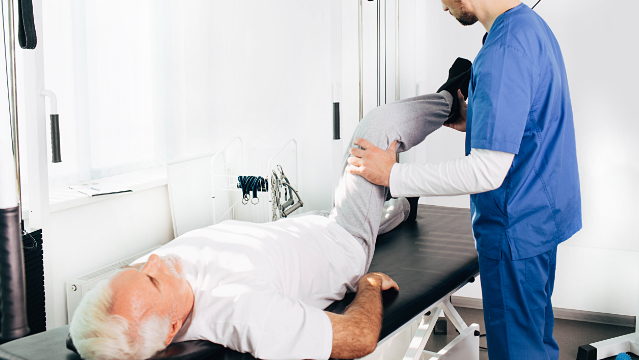Health Blog
Physical therapy provides the best option for most hip pain problems

After hip pain develops, movement can become a taxing affair. Standing up from a chair, getting into a car, and walking even short distances may be met with intense strain and discomfort. As a result, some individuals will become less active so as to avoid the pain that comes with it, even though inactivity can lead to worse outcomes in the long run.
In addition to avoiding movements that could potentially be painful, some patients will turn to at–home remedies like ice and heat, pain medications, gentle stretching, or self–massage. All of these interventions may serve a purpose and alleviate pain to some degree, but for pain that persists for several weeks after taking these initial steps, a more systematic approach will be needed.
Physical therapy is one of the many options available to address hip pain, but it is unique in that it teaches patients to overcome their limitations on their own by moving better and more efficiently. Physical therapy can also be performed effectively for patients of all ages and for the majority of conditions associated with hip pain, regardless of the level of severity. For patients with advanced hip osteoarthritis, it represents an alternative to surgery as well, which can lead to significantly lower health costs while producing similar outcomes.
A typical physical therapy treatment program for hip pain
After conducting an initial evaluation, a physical therapist will design a personalized treatment program tailored to patient’s abilities, goals, and preferences. These programs will differ depending on the condition(s) present, but common elements found in most include the following:
- Strengthening exercises that focus on the muscles of the hip, as well as the core and legs, which will also affect hip function
- Stretching exercises to increase the flexibility and range of motion of the hip joint
- Manual therapy, in which the physical therapist will gently move muscles and joints to decrease pain and improve motion and strength
- Movement re–education, which will include self–stretching techniques to help restore normal motion of the hip, back and legs; advice will also be offered on what stretches and movements should be avoided
There is large and growing body of evidence to support physical therapy as an effective intervention for a wide range of hip–related conditions. In one type of study called a systematic review and meta–analysis, researchers collected and analyzed all the available research on two commonly–used physical therapy interventions—manual therapy and exercise therapy—for hip osteoarthritis, one of the most common causes of hip pain. They identified a number of studies that backed up the proposed benefits of these interventions, finding that both exercise therapy and manual therapy reduced pain and improved physical function for patients with hip osteoarthritis.
Therefore, if you are currently impacted by hip pain of any sort that is complicating your daily life, we advise you to give us a call. Let us help you with an individualized treatment program to help empower you and regain your function by using your own capacity for movement.
July 30, 2020
Back to Health BlogHEALTH BLOG
- A Personalized Physical Therapy Program Can Assist with Whiplash
- Why Older Adults Should Incorporate an Exercise Program
- After an Achilles Injury, Physical Therapists Can Help with Recovery
- AI Can Answer Questions But It’s Best to See a Physical Therapist
- Physical Therapy Can Help With Symptoms of Wryneck
- Reduce the Risk of Pickleball Fractures By Taking Proper Precautions
- Physical Activity May Slow the Progression of Parkinson's Disease
- Too Much Salt in Your Diet? Learn the Dangers of High Sodium Intake
- Suffer From Lower Back Pain? Might Be Time to Take A Break
- The Road to Recovery: Preventing Re-Injury After ACL Surgery
RECENT ARTICLES

- 11 Possible Reasons Your Back HurtsJune 22, 2020

- What Conditions Can a Chiropractor Treat?May 25, 2020

- A Simple Guide to Better PostureApril 30, 2020

- Is Acupuncture Right for Me When I’m Afraid of Needles?March 30, 2020

- Stretching Done Right — How and When to StretchFebruary 26, 2020

